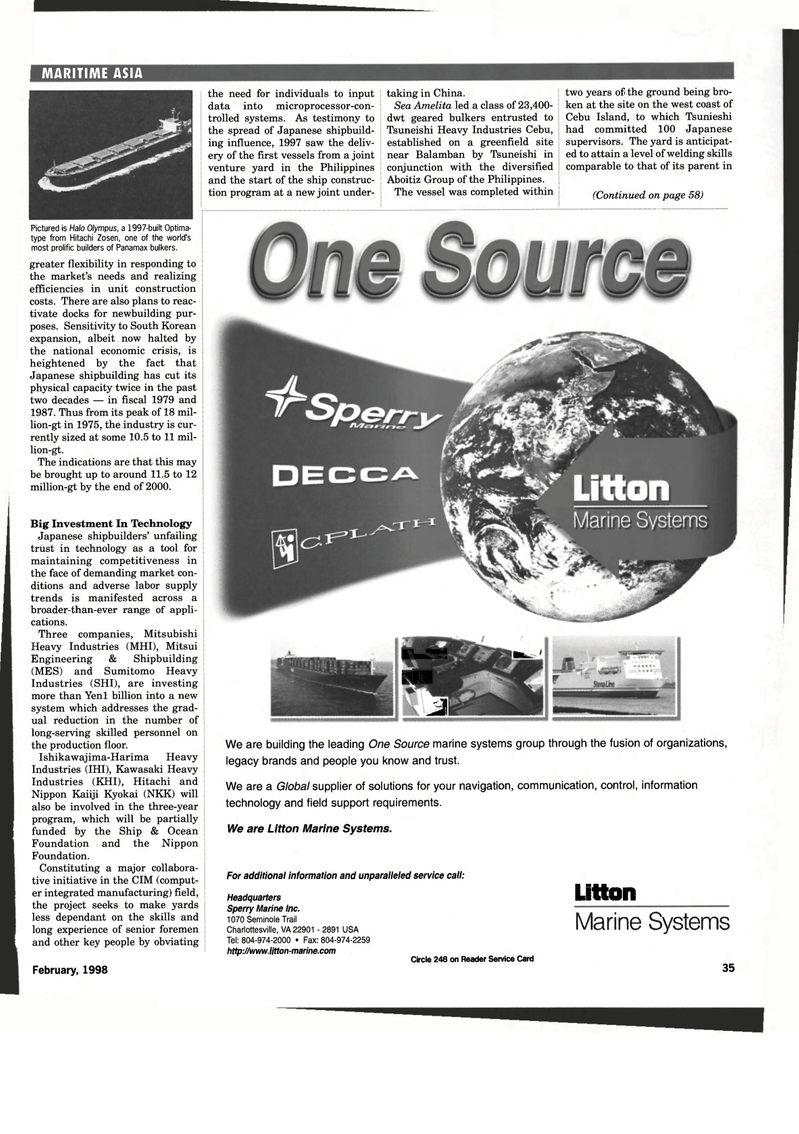
Page 35: of Maritime Reporter Magazine (February 1998)
Read this page in Pdf, Flash or Html5 edition of February 1998 Maritime Reporter Magazine
MARITIME ASIA
Pictured is Halo Olympus, a 1997-built Optima- type from Hitachi Zosen, one of the world's most prolific builders of Panamax bulkers. greater flexibility in responding to the market's needs and realizing efficiencies in unit construction costs. There are also plans to reac- tivate docks for newbuilding pur- poses. Sensitivity to South Korean expansion, albeit now halted by the national economic crisis, is heightened by the fact that
Japanese shipbuilding has cut its physical capacity twice in the past two decades — in fiscal 1979 and 1987. Thus from its peak of 18 mil- lion-gt in 1975, the industry is cur- rently sized at some 10.5 to 11 mil- lion-gt.
The indications are that this may be brought up to around 11.5 to 12 million-gt by the end of 2000.
Big Investment In Technology
Japanese shipbuilders' unfailing trust in technology as a tool for maintaining competitiveness in the face of demanding market con- ditions and adverse labor supply trends is manifested across a broader-than-ever range of appli- cations.
Three companies, Mitsubishi
Heavy Industries (MHI), Mitsui
Engineering & Shipbuilding (MES) and Sumitomo Heavy
Industries (SHI), are investing more than Yenl billion into a new system which addresses the grad- ual reduction in the number of long-serving skilled personnel on the production floor.
Ishikawajima-Harima Heavy
Industries (IHI), Kawasaki Heavy
Industries (KHI), Hitachi and
Nippon Kaiiji Kyokai (NKK) will also be involved in the three-year program, which will be partially funded by the Ship & Ocean
Foundation and the Nippon
Foundation.
Constituting a major collabora- tive initiative in the CIM (comput- er integrated manufacturing) field, the project seeks to make yards less dependant on the skills and long experience of senior foremen and other key people by obviating
February, 1998 the need for individuals to input data into microprocessor-con- trolled systems. As testimony to the spread of Japanese shipbuild- ing influence, 1997 saw the deliv- ery of the first vessels from a joint venture yard in the Philippines and the start of the ship construc- tion program at a new joint under- taking in China.
Sea Amelita led a class of 23,400- dwt geared bulkers entrusted to
Tsuneishi Heavy Industries Cebu, established on a greenfield site near Balamban by Tsuneishi in conjunction with the diversified
Aboitiz Group of the Philippines.
The vessel was completed within two years of the ground being bro- ken at the site on the west coast of
Cebu Island, to which Tsunieshi had committed 100 Japanese supervisors. The yard is anticipat- ed to attain a level of welding skills comparable to that of its parent in (Continued on page 58)
KlmES! ^^ / 3EH -J!
We are building the leading One Source marine systems group through the fusion of organizations, legacy brands and people you know and trust.
We are a Global supplier of solutions for your navigation, communication, control, information technology and field support requirements.
We are Litton Marine Systems.
For additional information and unparalleled service call:
Headquarters
Sperry Marine Inc. 1070 Seminole Trail
Charlottesville, VA 22901 - 2891 USA
Tel: 804-974-2000 • Fax: 804-974-2259 http://www.litton-marine.com
Litton
Circle 248 on Reader Service Card
Marine Systems 35

 34
34

 36
36
